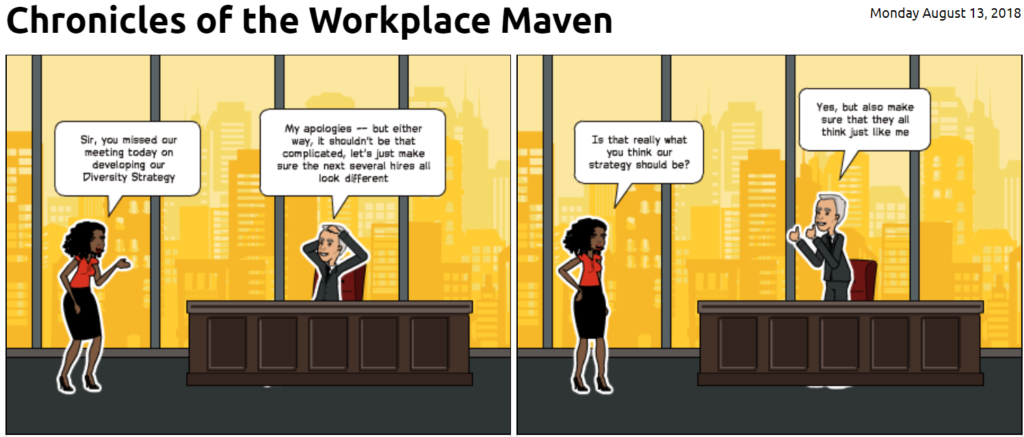For years, studies have supported the notion that having a more diverse workforce is a clear competitive advantage. While every year, organizations continue to pour their time and resources towards public efforts of diversity, there have only been marginal improvements in implementing meaningful diversity strategies that truly diversify workplaces. It is undeniable that there is much that remains to be accomplished when it comes to achieving racial and gender diversity in the workplace, however, a truly diverse workforce would go beyond race and gender, and organically include a blend of diverse thoughts and experiences. Disabled workers, older workers, younger workers, workers from different geographies and industries and even those employees with different work experiences are all diverse groups of people that would add value to diversifying an organization. Organizations with a wide range of employees enjoy broader skill sets, experiences, and points of view, all of which combine to provide diverse organizations with a powerful advantage over homogenous ones. Here are just a few benefits of having an effective diversity strategy that you can’t ignore.
1. Diversity Fosters Innovation
Diverse experiences, perspectives and backgrounds are key drivers to the development of new ideas and solutions. In fact, Forbes’ “Global Diversity and Inclusion: Fostering Innovation Through a Diverse Workforce” found that among companies with more than $10 billion in annual revenues, 56 percent strongly agreed that diversity helps drive innovation. Why? Because having a diverse group of people on the same team helps others view issues differently leading to distinct solutions. Think about it – if you have five people with the same background looking at the same problem, they will likely come up with similar solutions. Whereas, if you instead have a diverse group of five people looking at the same problem, the experiences of those individuals will inevitably influence not only the way they see the problem but also the possibilities of how the problem can be solved – leading to a variety of thoughts and solutions. This theory is highlighted in a study from Northwestern and BYU, where researchers observed the impact of a socially distinct newcomer joining an already established group. In that study, the mere presence of a newcomer with different opinions made the pre-existing group members question themselves and their approach leading to a higher level of performance.
It just makes sense. People with different backgrounds, beliefs, cultures, age, gender and upbringings will have different perspectives, opinions, skills and ways to approach challenges that will only benefit your customers and your business.
2. Diversity Leads to Better Customer Service
Having a diverse workforce will help your organization relate to a broader customer base leading to better customer service. With today’s advances in technology and communication, most businesses have the ability to expand to cross-cultural and geographic boundaries. To find success, companies need to be able to communicate effectively with its customers and understand their needs. A workforce that has a genuine reflection of their customers supports a deeper understanding of their customer’s needs and increases the opportunities to provide them with the connection they seek and value. Customers feel more connected to a business when they speak to people that understand their experiences and perspectives as well as recommend products and services with an appreciation for their unique situations. For example, an employee with a disability is going to be more astutely aware of the needs of others in the disability community and would be an excellent resource for identifying relevant solutions for that customer segment. When your workplace is home to a diverse group of individuals, your company can more effectively meet the needs of a broader customer base. Being able understand and appreciate the nuances and differences of your customers will help forge lasting customer relationships.
3. Diversity Attracts Better Talent
The competition to land the most talented workers continues to grow more intensely with each day that goes by. An effective diversity strategy can set an organization apart as that differentiator worthy of capturing the best talent. How? Not only does diversity open an organization up to being able to draw from a greater talent pool, but it also attracts that top talent that places value in diversity as factor in deciding which organization to join. Just how relative is a company’s diversity to attracting today’s top talent? According to a Glassdoor survey, two thirds of job seekers indicated that diversity was important to them when evaluating companies and job offers. Moreover, in a 2017 survey by PwC, 54% of women and 45% of men surveyed said they researched if a company had diversity & inclusion policies in place when deciding to accept a position with their most recent employer. The importance of diversity is even moreso prevalent when you consider the millennial workforce which has been said to be the most diverse working generation in history. Workplace diversity signals a welcoming environment where people can bring their whole selves to work – understanding the value of that to a job seeker will take your recruitment strategy to the next level and open you up to top talent you wouldn’t have otherwise been able to attract.
This discussion only highlights 3 of the many ways an organization benefits from diversity. Implementing an effective diversity strategy has become increasingly important and will continue to be key for organizations. In the end, diverse teams have been proven to deliver tangible business results, reduce risk exposure, and drive innovation providing organizations with a sure competitive advantage. Interested in developing an effective diversity strategy, we’d be happy to help. Contact us at info@hrandbeyond.com.

